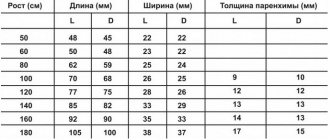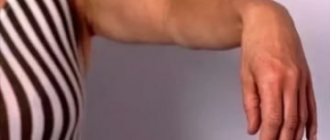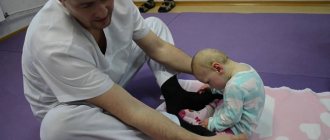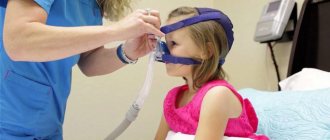Symptoms and signs
This pathology is often called both a syndrome and a symptom. Both names are applicable, because there may be more than one symptom. In medical institutions, when diagnosing children, it is designated as a symptom. The setting sun symptom in newborns is often also called Graefe's syndrome.
This is the official term. It is used by doctors when observing characteristic symptoms in a child or an adult patient. Currently, Graefe syndrome is called hydrocephalic, it refers to a neurological pathology. In Graefe syndrome, nerve cells degenerate.
Typically, such babies have motionless eyes and often tilt their heads back. The main sign of pathology is a white strip of sclera located between the iris and the upper eyelid. It is easy to notice when the child looks down. Often this is the only sign.
If no further symptoms are observed, you can expect that the disease will soon disappear on its own. If, in addition to the white stripe above the pupil, other signs are observed, it is necessary to show the baby to the pediatrician as soon as possible. There can be many signs that accompany the main symptom.
Namely:
- wandering gaze;
- decreased tone of the arms and legs;
- reduced visual acuity;
- slightly trembling body;
- frequent regurgitation;
- quiet crying for no apparent reason;
- cyanosis of the skin between the upper lip and nose, as well as on the arms and legs;
- pronounced descending strabismus;
- open sutures of the skull;
- convulsions that appear in attacks;
- throwing the head back;
- frequent, shallow breathing;
- increased head diameter;
- too prominent fontanelle;
- marble skin color.
The setting sun symptom in newborns is characterized by 2 main manifestations:
- If it is too pronounced and is always observed, it can be assumed that the cause of the pathology is damage to the brain and nervous system.
- If the expression is less pronounced and the signs appear rarely, this will not be considered a disorder.
The symptom of the setting sun in newborns is symptoms of the disease.
The influence of the brain on eye motor disorders can be caused by organic changes or damage to the 3rd and 4th pairs of cranial nerves. They are responsible for the downward movement of the pupils: for lowering the gaze.
The development of setting sun syndrome occurs under the influence of many factors that have a negative impact on the nervous system that has not yet had time to strengthen, thereby provoking the appearance of pathology.
As the child’s body grows and develops, the central nervous system gradually adapts to the conditions, as a result of which the disease disappears.
It is necessary to remember: setting sun syndrome can develop not only in children. Its symptoms often appear in some adults.
In this case, the list of main features will be as follows:
- frequent headaches that occur at night;
- dizziness that occurs in attacks throughout the day;
- slow thought process;
- difficulty looking down;
- weakened memory and impaired concentration;
- hypertonicity of the muscles of the arms and legs;
- general lethargy of the body and frequent desire to sleep;
- involuntary attempts to walk on toes;
- manifestation of signs of dyspepsia, which include nausea and vomiting;
- development of diplopia: a condition in which there is double vision.
The development of pathology is based on the defective functioning of the nervous system. Cerebrospinal fluid can collect in the brain in large quantities. Its total volume is approximately 150 ml.
The body produces up to 180 ml per day. The rate of production depends on the perfusion pressure in the brain. The rate at which fluid is absorbed is influenced by venous and intracranial pressure. The increased volume of cerebrospinal fluid is the result of a violation of normal outflow.
There are 2 types of setting sun syndrome:
- The 1st appears when the position of the body changes. It disappears on its own a few weeks after the baby is born;
- Type 2 – when symptoms appear, regardless of the position of the patient’s body. In this case, medical attention is required.
Symptom of the setting sun, or why the eyes “go into the shadows”
Why does the symptom of the setting sun have such a poetic name? Because the white of the eye is like the sky - especially if the eyes are blue-rimmed, while its center is the cornea and iris with a flat well of the pupil, in this small-scale sky they are very reminiscent of the sun.
And this “sun” is almost always in, with the exception of a rare “glancing” to the side or a mannered rolling of the eyes upward at the moment of particularly “juicy” sensations.
But sometimes there come moments when the “sun” noticeably leans toward the “horizon” of the lower eyelid, moving downward and partly inward, leaving above it an unnaturally wide strip of sclera usually covered by the upper eyelid.
However, the “sun” cannot completely set behind the lower eyelid, because this is impossible for purely biological reasons - the muscles that rotate the eyeball in different directions have a length and limit of contractility, so none of them will “pull” their “counter” ” – a muscle with opposite intentions.
But the “eye-turning” muscles do not work on their own; they are executors of someone else’s “higher will”, emanating from the nuclei of the oculomotor and trochlear nerves (III and IV pairs of cranial nerves), located in the bottom of the III ventricle of the brain.
Pathogenesis of the symptom
And the processes in the third ventricle, which is part of the liquor-conducting system, sometimes occur strange and unnatural, and it can become unusable for a variety of reasons.
Take, for example, hydrocephalus - dropsy of the brain. More precisely, a case caused by the causes of increased intracranial pressure. Yes, not abstract, but concrete, associated with the area of the aqueduct in the midbrain and its bridge, because it is near its bottom that the nuclei of the oculomotor nerves are located, and it is compression of the brain stem that leads to a disorder of their function.
This same area becomes problematic when:
- hemorrhage in the intraventricular area;
- hydrocephalus of posthemorrhagic origin;
- nuclear jaundice.
There are other nervous pathologies, including both functional and organic disorders, developing both in the area of exits and the routes of the III and IV pairs of cranial nerves - both in the form of isolated and combined lesions.
But it is precisely with hydrocephalus that the setting sun syndrome manifests itself most often and most clearly, which allows it to be used as a diagnostic criterion of a neurological nature.
This pathological sign can also arise from a man-made, surgical intervention - the creation of a ventriculoperitoneal shunt, which should eliminate the consequences of hydrocephalus of post-hemorrhagic etiology. In this case, if there are no other organic lesions of the brain stem, the symptom gradually disappears over time.
"Setting Sun" of newborns
Being a frightening phenomenon for parents, Graefe's symptom (the second name for the setting sun symptom, not to be confused with Graefe's syndrome), which appears in the first months in newborns, can go away completely without consequences when the child's nervous system reaches the proper level of maturity.
The symptom of “surprisedly swollen” eyes can be not only a consequence of intrauterine growth retardation or prematurity, but also a feature of the child’s constitution, and therefore persist into adulthood.
The need for especially careful observation and, if necessary, treatment arises with diagnostically confirmed hypertensive-hydrocephalic syndrome, although cases of its diagnosis in pediatric medical practice are not uncommon.
Modern methods of diagnosis can help in difficult cases in the form of:
- neurosonography;
- MRI of the brain.
How to Test a Patient for a Symptom
If in a pronounced case the symptom is easily observed in a calm state, then in a doubtful case, “sunset” is especially indicative when rotating the head with the eyes following an attractive object.
The gaze cannot fixate on an object slowly moving downwards, and the eyes periodically “float” down and partly inward, exposing a strip of sclera of inadequate width.
The combination of a positive test with nystagmus and convergent strobism should be the reason for a more in-depth neurological study.
Causes
The symptom of a setting sun in a newborn is an individual feature of the structure of the eyes or insufficient maturity of the nervous system. After some time, the pathology disappears on its own, so young parents should not worry too much about the child’s condition. However, visits to the doctor should not be neglected.
One of the causes of setting sun syndrome is hypoxia, which can result from birth injuries.
The following factors can influence the development of the setting sun symptom:
- pathologies in the mother that appeared late in pregnancy;
- worsened chronic diseases during pregnancy;
- ischemia;
- infectious diseases.
In addition, setting sun syndrome can also occur as a result of the following diseases suffered by the baby:
- meningitis;
- disrupted functioning of the endocrine system;
- brain cyst;
- injuries received during birth;
- spinal cord injuries;
- disruptions in the hormonal system;
- neoplasms in the brain;
- metabolic disorders;
- fetal hypoxia.
Often, setting sun syndrome begins to develop as a result of premature or, conversely, late birth. Heredity plays a significant role. Many diseases that the mother suffers from increase the risk of this syndrome in the baby.
Often, signs of setting sun syndrome appear in a baby who was born before the 36th or after the 42nd week. If signs of setting sun syndrome appear in adults, it means that it is acquired.
Most often, pathology is caused by the following factors:
- metabolic disorder;
- head injuries;
- infectious diseases.
The risk group includes people with a weakened nervous system. It may function poorly or be underdeveloped.
Why is it developing?
Of course, many, especially relatives of older people with dementia, are concerned about the reasons for the development of this condition. “The causes of this condition include several aspects, both pathophysiological (disruption of circadian rhythms) and psychological (tiredness at the end of the day, disorientation due to low lighting, unfamiliar environmental conditions, for example, while in a hospital),” says Yulia Rubleva .
However, not all people diagnosed with dementia are susceptible to this kind of experience, as Yulia Rubleva says. However, it is considered a fairly common manifestation in such patients.
Physical education for the brain. What exercises can help delay dementia? More details
Treatment methods
Before starting therapy, parents should make sure that the observed signs actually indicate setting sun syndrome. It is necessary to look at the corresponding photographs and understand what the symptoms look like. After looking at the photo, you need to pay attention to your child’s eyes.
When the first signs appear, you should consult a doctor. To accurately identify the signs of sundowning syndrome, it is necessary to conduct a diagnosis.
Diagnostic measures should begin with a visual examination. Since the pathology has many striking distinctive features, a specialist will be able to accurately identify it. To do this, the patient must undergo hardware and laboratory diagnostics.
In this case, the following methods are used:
- Blood and urine examination.
- Lumbar puncture.
- Determination of visual acuity and fundus examination.
If the disease is detected, specialists will use instrumental diagnostics:
| Method | Description |
| Ultrasound test | Allows you to study the brain without radiation. It is performed on infants to study the structure of the brain and anatomical formations. The technique is safe and painless, so it is ideal for repeated use. |
| X-ray of the skull | Required to assess the condition of the bones. This procedure provides little information, but in some cases it cannot be avoided. With its help, you can choose the right treatment tactics and monitor the effectiveness of the measures taken. |
| Dopplerography | This method provides a lot of information and allows you to study the vessels of the brain, assessing the rate of blood flow to it. This procedure is safe. |
| CT and MRI | They make it possible to identify defects and fractures that have appeared in bone tissue, but do not make it possible to identify vascular diseases. |
| Rheoencephalography | Vascular examination. |
| Electroencephalography | A technique aimed at identifying tumors and epilepsies. Through the electrodes used, it is possible to obtain the necessary information about the electrical activity of the brain. |
After an accurate diagnosis is made, the child is transferred under the close supervision of a doctor. If sunburn symptoms are present, your pediatrician may prescribe conservative treatment. At home, you can massage your child and do gymnastics with him.
A mandatory requirement is to maintain the correct daily routine. Situations in which the child’s intracranial pressure may increase should not be allowed. A child suffering from this pathology will benefit from water procedures: swimming and diving.
Sometimes treatment with drugs belonging to the group of nootropics may be required. They have a positive effect on brain circulation. Treatment with diuretics is also possible.
The symptom of a setting sun in a newborn with the underlying cause of intracranial injury will require immediate medical intervention. First, a neurosonography procedure will be performed, which will allow us to examine the structure of the brain. After this, a decision will be made on the necessary treatment.
Signs of brain damage also include nystagmus, a disorder of vascular nature. With such a symptom, the pediatrician suspects vascular lesions in the head or cervical spine.
You can overcome the disease if you approach its treatment comprehensively. As a rule, pathology is treated in special neurological centers.
Diagnostic methods
To make a diagnosis, laboratory and hardware examination methods are used:
- Ultrasound (neurosonography of the brain), EEG, EchoEG, REG, examination by an ophthalmologist assessing the condition of the vessels of the visual organs and fundus of the eye - if hydrocephalus is suspected.
- X-ray, lumbar puncture, general neurological examination - if increased intracranial pressure is suspected.
- Scintigraphy, hormone analysis, ultrasound of the thyroid gland for Graves' disease and the presence of endocrine problems in the mother. With thyrotoxicosis, the level of total T4 and T3 will be elevated.
- Depending on the symptoms of the disease, the following are additionally used: a general analysis of feces and urine, assessing the functioning of internal organs;
- Dopplerography is a method that allows you to examine cerebral vessels and determine the speed of blood flow;
Having received the examination results, the specialist makes a diagnosis and prescribes appropriate treatment.
Medicines
Drug treatment is based on the use of the following drugs:
- diuretics. These are substances that effectively remove excess water from the body. A common remedy is Furosemide;
- nootropics. They normalize the activity of the nervous system and neurometabolic processes occurring in the brain;
- vitamins. As a rule, these are complexes aimed at supporting the body. The most famous of them are Kombilipen and Milgamma;
- agents that increase vascular tone . They normalize blood flow to the brain. The most famous examples are Actovegin and Curantil;
- antibiotics and antiviral agents . Prescribed only when absolutely necessary;
- sedatives . These include Tazepam, Diazepam.
The doctor should choose the medicine based on the results of diagnosis and subsequent monitoring of the patient.
If a patient experiences a severe attack of the syndrome, emergency treatment is necessary. This may be a dehydration procedure in which Lasix is injected into the muscles. Instead, other means that have a similar effect can be used.
What is the essence of the problem
“According to the World Health Organization definition, dementia is a syndrome in which there is a progressive decline in mental abilities (memory, understanding, speech and the ability to navigate, count, cognition and reason) to a greater extent than expected with normal aging,” the specialist notes. . According to statistics, she says, there are about 50 million people with dementia in the world, with up to 10 million new cases of the disease occurring every year. The most common form of dementia is Alzheimer's disease (60-70% of all cases), but there are many other forms.
As a result of dementia, people can develop various pathological conditions.
Staying ahead of risks. How to prevent potential hereditary dementia? More details
Treatment using folk remedies
In newborns, traditional medicine helps normalize the condition of the setting sun symptom. However, these prescriptions should not be considered as primary therapy. They should be used simultaneously with drugs of official medicine in order to increase efficiency.
The following folk remedies help to successfully overcome the signs of setting sun syndrome:
- boiled plantain leaves (you can use both dry and fresh);
- mulberry decoction;
- mint infusion with the addition of a small amount of eucalyptus essential oil and hawthorn berries;
- lemon;
- garlic;
- infusion of string and nettle.
All of these remedies normalize intracranial pressure and effectively combat the symptoms of pathology.
Causes of pathology
Unfavorable conditions can provoke Graefe's symptom in newborns, for example:
- pathological pregnancy;
- difficult, late, protracted labor;
- prematurity;
- birth injury;
- intrauterine oxygen deficiency with fetal growth retardation;
- infectious diseases of the genitourinary system in the mother with subsequent infection of the child;
- congenital brain abnormalities (cyst, dropsy, underdevelopment of brain structures);
- chronic illnesses;
- hereditary predisposition;
- endocrine disorders.
The causes of SpH in adults and elderly people may be hidden in:
- persistently increased level of intracranial pressure;
- infectious diseases affecting parts of the brain (meningoencephalitis, malaria);
- stroke (recent and long ago);
- traumatic brain injuries;
- thyrotoxicosis;
- tumor formations related to brain structures, cancer;
- disrupted metabolic processes.
Possible consequences and prognosis
In most cases, even without treatment, the symptoms of setting sun syndrome in a baby disappear on their own. The child's eyeball may return to normal within a month. Sometimes it may take a little longer.
If no negative factors are observed during the development of the newborn, then the nervous system will soon fully recover and all signs will disappear.
However, there are times when symptoms do not go away and other problems may appear:
- vomit;
- frequent crying for no reason;
- tense fontanelle at rest;
- weakening of muscles;
- throwing the head back;
- strabismus.
In all of the above cases, the doctor prescribes additional tests.
If symptoms become more severe over time, surgery may be considered. In particular, neuroendoscopic surgery can be performed; another surgical option is bypass surgery.
Reasons for the development of the disease
The condition we are considering in some cases can occur in infants who are in quite good health. This is due to the fact that the first time after birth, the baby’s nervous system actively adapts to the changed conditions. In the absence of any disease, this symptom will most likely disappear within a few weeks or months after birth.
In newborns, this syndrome most often appears for the following reasons:
- difficult childbirth;
- prolonged pregnancy or premature birth of a baby;
- infectious diseases suffered by the expectant mother during pregnancy;
- chronic diseases of the mother;
- heredity.
In these cases, immediately after identifying the syndrome, the baby will be registered with a pediatric neurologist for further monitoring of the development of the disease.
It is worth clarifying that if an uncharacteristic position of the eyes is noted during active interaction with the baby, then most likely, over time, the disease may go away on its own. However, if the condition persists long after birth, the syndrome is most likely due to high intracranial pressure. In this case, leaving the child without treatment is highly not recommended.
- symptoms appear when the child’s body position changes;
- symptoms appear systematically, regardless of the child’s movement and position.
In the first case, the disease should go away on its own within two to three months. Its occurrence is associated with defective development of the nervous system.
In the second case, it is necessary to urgently contact a specialist to conduct several tests, studies and further prescribe treatment.
Neuroendoscopic surgery
The essence of this operation is to perforate the bottom of the third ventricle. The risks of any complications in this case are minimal. However, the expected effect is not easy to achieve, so after the operation is completed, a shunt will need to be installed after some time.
Bypass surgery
Shunting is the installation of a special system that prevents the retention of cerebrospinal fluid in the brain. It gradually passes into the atrium or into the abdominal cavity.
Currently, bypass surgery is the most effective method of getting rid of the symptom of the setting sun and its secondary manifestations. However, this procedure is too risky. After the shunt is installed, the child is entitled to disability, because a foreign body will now be present in his body.
The main danger of shunting is that the installed shunt can stop performing its main function at any time. Cerebrospinal fluid will again begin to accumulate in the brain and surgical intervention will be immediately required.
Complications
If the necessary measures are not taken in a timely manner, setting sun syndrome, accompanied by additional symptoms, can lead to various serious complications.
The most common illnesses that appear are:
- loss of vision;
- hearing loss;
- slow development of muscles and nervous system;
- epilepsy;
- coma;
- severe forms of paralysis;
- urinary incontinence.
In some cases, death is possible. For children, the prognosis for the course of pathology in most cases is positive. After some time, the blood pressure in the child’s body will return to normal. If this disease is observed in an adult, then it is necessary to take the patient more seriously.
In this case, the risk of serious complications increases significantly. Treatment should be started as soon as possible. The sooner the right steps are taken, the greater the likelihood that serious health problems will be successfully prevented.
With timely diagnosis and proper treatment, setting sun syndrome in a newborn will have a favorable outcome. The main condition is compliance with the pediatrician’s recommendations.
What parents should do
You can find out what the symptoms look like from photographs of newborns with setting sun syndrome. The first signs of this phenomenon should be a mandatory visit to the pediatrician. In addition, you should never neglect a routine visit to your doctor. It is also recommended to be examined by a neurologist, although a visit to this doctor is not mandatory. Nevertheless, the nervous system is of great importance for a person, so it is very important to identify any deviations from the norm in a timely manner.
After looking at the photo of setting sun syndrome in children, pay attention to your baby, if there is even the slightest suspicion, consult a doctor and undergo another examination to prevent the development of a serious pathology. When diagnosed early, the syndrome has a favorable outcome if parents follow all the doctor’s recommendations.
Treatment
Treatment methods for Graefe syndrome depend on diagnostic results; neurosurgeons, neurologists and ophthalmologists are involved in eliminating the disease
If Graefe's symptom in a newborn does not have accompanying pathologies, then it does not require specialized treatment. The problem goes away as the child grows up if the following recommendations are followed:
- correct daily routine;
- careful personal hygiene;
- the child should be fed upon request;
- professional massage.
All this helps to quickly strengthen the baby’s nervous system.
If a baby is diagnosed with Graefe syndrome (and not just a symptom), the pathology will be treated by the following specialists:
- neurosurgeon;
- neurologist;
- ophthalmologist.
The disease can only be overcome with an integrated approach. As a rule, Graefe syndrome in newborns is treated in specialized neurological centers.
Drugs
Drug therapy is based on the use of the following drugs:
- Diuretics. The action of these medications is based on removing excess fluid from the body. The most famous representative of drugs in this group is Furosemide.
- Nootropics. They optimize the activity of the central nervous system, normalize neurometabolic processes occurring in the brain.
- Multivitamin complexes that provide support for the body. The most famous representatives of the group are drugs such as Milgamma and Combilipen.
- Drugs to improve vascular tone and normalize cerebral circulation - Curantil, Actovegin.
- Sedatives – Diazepam, Tazepam.
- Antiviral drugs and antibiotics (if necessary).
Medicines are selected by a doctor who focuses on the patient’s age and the causes of the pathology
Not only health depends on the results of therapy, but the possibility of a full life for the patient is selected by the doctor, who focuses on the patient’s age and the causes of the pathology
If a patient experiences a severe attack of the syndrome, he needs emergency treatment. As a rule, it involves a dehydration procedure. To do this, intramuscular injections of the drug Lasix or its analogues are performed.
Physiotherapy
The following procedures help stabilize the patient's condition:
- acupuncture;
- exercise therapy;
- electrophoresis;
- magnetotherapy.
Surgery
If conservative treatment of Graefe syndrome is ineffective, surgical intervention is used to improve the outflow of cerebrospinal fluid from the skull. Surgical treatment options:
- bypass;
- ventricular or lumbar puncture;
- endoscopic surgery.
ethnoscience
Folk remedies can significantly improve the patient's condition. However, these prescriptions should not be considered as full-fledged treatment - they only improve the effectiveness of official medicine.
The most popular treatments for Graefe syndrome are:
- Tincture of mint leaves with the addition of eucalyptus essential oil and hawthorn fruit.
- Infusion of nettle and string.
- Mulberry decoction.
- A decoction of dry or fresh plantain leaves.
Eating foods such as garlic and lemon can significantly alleviate the patient's condition.
The above means help normalize intracranial pressure. They effectively combat the manifestation of pathological symptoms. However, before taking traditional medicines, it is necessary to consult a specialist. He will certainly be able to offer the most effective and safe methods.
Conditions in which Graefe's symptom occurs
In case of prematurity, SpH goes away on its own as the nervous system matures. However, this condition is most often associated with the presence of neurological diseases, which must be identified and treated as soon as possible.
Hydrocephalus
Graefe syndrome in adults and newborns most often causes SpH. This pathology develops when the membranes of the brain secrete a large amount of cerebrospinal fluid and do not have time to absorb it back. In this case, cerebrospinal fluid (CSF) accumulates and puts pressure on the brain tissue, causing severe neurological symptoms. In addition to the strip of sclera in the eyes, the main symptoms of hydrocephalic disease in newborns are:
- weakening of innate reflexes (difficulty with sucking and swallowing, decreased strength of the grasping reflex);
- tremor of the chin and limbs;
- strabismus;
- spitting up like a fountain;
- muscle hypotonia, leading to difficulties in holding the head, drooping arms and legs, lack of physiological flexion-extension hypertonicity);
- marbling of the skin, blueness of the nose, lips and earlobes;
- a noticeable increase in head circumference (in children under one year);
- swelling of the optic discs;
- protrusion of the fontanel.
Sunset syndrome in adults differs from symptoms in newborns, accompanied by:
- frequent attacks of morning headaches radiating to the temples;
- nausea, vomiting;
- attacks of dizziness;
- feeling of constant fatigue;
- difficulty moving the eyeballs and head;
- pale skin;
- the presence of hypertonicity of the muscles of the limbs;
- the appearance of strabismus;
- deterioration of attentiveness, memory, mental activity.
Intracranial hypertension
Intracranial pressure can increase when:
- hydrocephalus;
- venous stagnation, when blood accumulates and compresses the meninges;
- cerebral edema;
- proliferation of tumor formations.
In children, this syndrome manifests itself clearly:
- lack of appetite and weight loss;
- lethargy, moodiness;
- slow overgrowth of the fontanel;
- divergence of cranial sutures;
- bulging and pulsating fontanel;
- muscle hypertonicity;
- seizures;
- spitting up like a fountain.
In adults, symptoms of ICP look like this:
- headache;
- deterioration of vision and memory;
- attacks of dizziness;
- absent-mindedness and inattention;
- drowsiness, lethargy;
- surges in blood pressure.
Kernicterus
Severe damage to brain tissue due to the toxic effects of “indirect” bilirubin often causes SpH. This condition in children is caused by:
- incompatibility of Rh blood;
- toxoplasmosis;
- jaundice of newborns;
- diabetes mellitus in the mother;
- birth injuries;
- sepsis.
Despite the diverse causes of the pathological process, its signs are always the same:
- weakness;
- monotonous crying;
- muscle hypotonicity;
- refusal to eat;
- stiff neck;
- signs of cerebral palsy.
The rapid increase in clinical symptoms leads to a sharp deterioration in the baby’s condition, which can lead to death.
Graves' disease
Graefe's symptom in children is often encountered with the development of thyrotoxicosis. The disease is transmitted from a sick mother to the newborn. With toxic goiter, the baby receives a huge amount of immunoglobulins through the umbilical cord, which remain in his blood for up to a year. They are gradually eliminated from the body. Signs of thyrotoxicosis in infants:
- goiter;
- hyperexcitability;
- increased sweating;
- insatiable appetite;
- frequent vomiting and diarrhea leading to weight loss;
- various disorders: Mobius syndrome, the “rising” sun symptom, protrusion of the eyeballs;
- early ossification of cranial sutures.
Symptom or syndrome: two big differences
First of all, you need to understand the terms that the doctor uses when making a diagnosis. For example, when we talk about a symptom, we do not mean a disease, but a characteristic individual sign of a disease or a sign of a pathological (abnormal, unusual) condition.
If we are talking about a syndrome, the situation becomes more complicated. By definition, a syndrome is a complex of symptoms of a disease, united by common signs of occurrence and mechanisms of development. Both the symptom and Graefe's syndrome are named after a German ophthalmologist who lived in the 19th century. If Graefe syndrome is diagnosed in newborns, check with your doctor what he means. Why?
This phenomenon is also called setting sun syndrome. With all this, nothing else bothers the baby, and the neurosonographic examination is quite satisfactory.
Setting Sun Symptom
Nothing serious happens in this case. Slow eyelid movement may be due to immaturity of the nervous system or individual structural features of the eyeball. In this case, time heals, and the baby is periodically observed by an ophthalmologist and neurologist.
sunset syndrome
Authors : Zaitsev S.V.
published 08/20/2015 14:00 in the categories Nervous, mental and psychological diseases, Neurology and psychiatry
Key words: perinatal encephalopathy (PEP) or perinatal damage to the central nervous system (PP CNS), hypertensive-hydrocephalic syndrome (HHS); dilatation of the cerebral ventricles, interhemispheric fissure and subarachnoid spaces, pseudocysts on neurosonography (NSG), muscular dystonia syndrome (MSD), hyperexcitability syndrome, perinatal convulsions.
It turns out... more than 70-80%! Children of the first year of life come for consultation to neurological centers about a non-existent diagnosis - perinatal encephalopathy (PEP):
Child neurology is a relatively new field, but is already going through difficult times. At the moment, many doctors practicing in the field of infant neurology, as well as parents of infants with any changes in the nervous system and mental sphere, find themselves “between two fires.” On the one hand, the school of “Soviet child neurology” is excessive diagnosis and incorrect assessment of functional and physiological changes in the nervous system of a child in the first year of life, combined with long-outdated recommendations for intensive treatment with a variety of medications. On the other hand, there is often an obvious underestimation of existing psychoneurological symptoms, ignorance of general pediatrics and the fundamentals of medical psychology, some therapeutic nihilism and fear of using the potential of modern drug therapy; and as a result - lost time and missed opportunities. At the same time, unfortunately, a certain (and sometimes significant) “formality” and “automaticity” of modern medical technologies lead, at a minimum, to the development of psychological problems in the child and his family members. The concept of “norm” in neurology at the end of the 20th century was sharply narrowed; now it is intensively and not always justifiably expanding. Probably the truth is somewhere in the middle...
According to data from the Perinatal Neurology Medical Clinic and other leading medical centers in Moscow (and probably in other places), so far, more than 80%!!! Children in their first year of life are referred by a pediatrician or neurologist from a district clinic for a consultation regarding a non-existent diagnosis - perinatal encephalopathy (PEP):
The diagnosis of “perinatal encephalopathy” (PEP) in Soviet child neurology very vaguely characterized almost any dysfunction (and even structure) of the brain in the perinatal period of a child’s life (from about 7 months of intrauterine development of the child and up to 1 month of life after childbirth), arising as a result pathologies of cerebral blood flow and oxygen deficiency.
Such a diagnosis was usually based on one or more sets of any signs (syndromes) of a possible disorder of the nervous system, for example, hypertensive-hydrocephalic syndrome (HHS), muscular dystonia syndrome (MDS), hyperexcitability syndrome.
After conducting an appropriate comprehensive examination: clinical examination in combination with analysis of data from additional research methods (ultrasound of the brain - neurosonography) and cerebral circulation (Dopplerography of cerebral vessels), fundus examination and other methods, the percentage of reliable diagnoses of perinatal brain damage (hypoxic, traumatic, toxic-metabolic, infectious) is reduced to 3-4% - this is more than 20 times!
The most bleak thing about these figures is not only a certain reluctance of individual doctors to use the knowledge of modern neurology and conscientious delusion, but also a clearly visible psychological (and not only) comfort in the pursuit of such “overdiagnosis.”
Hypertension-hydrocephalic syndrome (HHS): increased intracranial pressure (ICP) and hydrocephalus
Until now, the diagnosis of “intracranial hypertension” (increased intracranial pressure ( ICP) ) is one of the most commonly used and “favorite” medical terms among pediatric neurologists and pediatricians, which can explain almost everything! and at any age, complaints from parents.
For example, a child often cries and shudders, sleeps poorly, spits up a lot, eats poorly and gains little weight, eyes widen, walks on tiptoes, his arms and chin tremble, there are convulsions and there is a lag in psycho-speech and motor development: “it’s only his fault - increased intracranial pressure." Isn't that a convenient diagnosis?
Quite often, the main argument for parents is “heavy artillery” - data from instrumental diagnostic methods with mysterious scientific graphs and figures. Methods can be used either completely outdated and uninformative /echoencephalography ( ECHO-EG ) and rheoencephalography ( REG )/, or examinations “from the wrong opera” ( EEG ), or incorrect, in isolation from clinical manifestations, subjective interpretation of normal variants during neurosonodopplerography or tomography.
Unhappy mothers of such children unwittingly, at the suggestion of doctors (or voluntarily, feeding on their own anxiety and fears), pick up the flag of “intracranial hypertension” and for a long time end up in the system of monitoring and treatment of perinatal encephalopathy.
In fact, intracranial hypertension is a very serious and quite rare neurological and neurosurgical pathology. It accompanies severe neuroinfections and brain injuries, hydrocephalus, cerebrovascular accidents, brain tumors, etc.
Hospitalization is mandatory and urgent!!!
Intracranial hypertension (if it really exists) is not difficult for attentive parents to notice: it is characterized by constant or paroxysmal headaches (usually in the morning), nausea and vomiting not associated with food. The child is often lethargic and sad, is constantly capricious, refuses to eat, he always wants to lie down and cuddle with his mother.
A very serious symptom can be strabismus or difference in pupils, and, of course, disturbances of consciousness. In infants, bulging and tension of the fontanelle, divergence of the sutures between the bones of the skull, as well as excessive growth of the head circumference are very suspicious.
Without a doubt, in such cases the child must be shown to specialists as soon as possible. Quite often, one clinical examination is enough to exclude or preliminarily diagnose this pathology. Sometimes additional research methods are required (fundus examination, neurosonodopplerography, computed tomography or magnetic resonance imaging of the brain).
Of course, expansion of the interhemispheric fissure, cerebral ventricles, subarachnoid and other spaces of the cerebrospinal fluid system on neurosonography (NSG) images or brain tomograms (CT or MRI) cannot serve as evidence of intracranial hypertension. The same applies to cerebral blood flow disorders isolated from the clinic, identified by vascular Dopplerography, and “finger impressions” on a skull x-ray.
In addition, there is no connection between intracranial hypertension and translucent vessels on the face and scalp, walking on tiptoes, trembling hands and chin, hyperexcitability, developmental disorders, poor academic performance, nosebleeds, tics, stuttering, bad behavior, etc. and so on.
That’s why, if your baby has been diagnosed with “PEP, intracranial hypertension”, based on “goggle” eyes (Graefe’s symptom, “setting sun”) and walking on tiptoes, then you shouldn’t go crazy in advance. In fact, these reactions may be characteristic of easily excitable young children. They react very emotionally to everything that surrounds them and what happens. Attentive parents will easily notice these connections.
Thus, when diagnosing PEP and increased intracranial pressure, it is naturally best to contact a specialized neurological clinic. This is the only way to be sure of the correct diagnosis and treatment.
It is absolutely unreasonable to begin treatment of this serious pathology on the recommendations of one doctor based on the above “arguments”; in addition, such unreasonable treatment is not at all safe.
Just look at the diuretic drugs that are prescribed to children for a long time, which has an extremely adverse effect on the growing body, causing metabolic disorders.
There is another, no less important aspect of the problem that must be taken into account in this situation. Sometimes medications are necessary and the wrongful refusal of them, based only on the mother’s (and more often than not the father’s) own conviction that medications are harmful, can lead to serious troubles. In addition, if there really is a serious progressive increase in intracranial pressure and the development of hydrocephalus, then often incorrect drug therapy for intracranial hypertension entails the loss of a favorable moment for surgical intervention (shunt surgery) and the development of severe irreversible consequences for the child: hydrocephalus, developmental disorders, blindness , deafness, etc.
Now a few words about the equally “adored” hydrocephalus and hydrocephalic syndrome . In fact, we are talking about a progressive increase in intracranial and intracerebral spaces filled with cerebrospinal fluid (CSF) due to the existing! at that moment of intracranial hypertension. In this case, neurosonograms (NSG) or tomograms reveal dilations of the ventricles of the brain, interhemispheric fissure and other parts of the cerebrospinal fluid system that change over time. Everything depends on the severity and dynamics of the symptoms, and most importantly, on the correct assessment of the relationships between the increase in intracerebral spaces and other neural changes. This can be easily determined by a qualified neurologist. True hydrocephalus, which does require treatment, like intracranial hypertension, is relatively rare. Such children must be observed by neurologists and neurosurgeons at specialized medical centers.
Unfortunately, in ordinary life such an erroneous “diagnosis” occurs in almost every fourth or fifth baby. It turns out that some doctors often incorrectly call a stable (usually slight) increase in the ventricles and other cerebrospinal fluid spaces of the brain hydrocephalus (hydrocephalic syndrome). This does not manifest itself in any way through external signs or complaints and does not require treatment. Moreover, if the child is suspected of having hydrocephalus based on a “large” head, translucent vessels on the face and scalp, etc. - this should not cause panic among parents. The large size of the head in this case plays practically no role. However, the dynamics of head circumference growth is very important. In addition, you need to know that among modern children it is not uncommon to have so-called “tadpoles” whose heads are relatively large for their age (macrocephaly). In most of these cases, infants with large heads show signs of rickets, less often macrocephaly due to the family constitution. For example, dad or mom, or maybe grandpa has a big head, in a word, it’s a family matter and doesn’t require treatment.
Sometimes, when performing neurosonography, an ultrasound doctor finds pseudocysts - but this is not a reason to panic at all! Pseudocysts are single round tiny formations (cavities) containing cerebrospinal fluid and located in typical areas of the brain. The reasons for their appearance, as a rule, are not reliably known; they usually disappear by 8-12 months. life. It is important to know that the existence of such cysts in most children is not a risk factor for further neuropsychic development and does not require treatment. However, although quite rare, pseudocysts form at the site of subependymal hemorrhages, or are associated with perinatal cerebral ischemia or intrauterine infection. The number, size, structure and location of cysts provide specialists with very important information, taking into account which, based on a clinical examination, final conclusions are formed.
Description of NSG is not a diagnosis! and not necessarily a reason for treatment.
Most often, NSG data provide indirect and uncertain results, and are taken into account only in conjunction with the results of a clinical examination.
Once again, I remind you of the other extreme: in difficult cases, sometimes there is a clear underestimation on the part of parents (less often, doctors) of the child’s problems, which leads to a complete refusal of the necessary dynamic observation and examination, as a result of which the correct diagnosis is made late, and treatment does not lead to the desired result.
Undoubtedly, therefore, if increased intracranial pressure and hydrocephalus are suspected, diagnosis should be carried out at the highest professional level.
What is muscle tone and why is it so “loved”?
Look at your child’s medical record: is there no such diagnosis as “muscular dystonia”, “hypertension” and “hypotension”? — you probably just didn’t go with your baby to the neurologist’s clinic until he was a year old. This is, of course, a joke. However, the diagnosis of “muscular dystonia” is no less common (and perhaps more common) than hydrocephalic syndrome and increased intracranial pressure.
Changes in muscle tone can be, depending on the severity, either a variant of the norm (most often) or a serious neurological problem (this is much less common).
Briefly about external signs of changes in muscle tone.
Muscular hypotonia is characterized by a decrease in resistance to passive movements and an increase in their volume. Spontaneous and voluntary motor activity may be limited; palpation of the muscles is somewhat reminiscent of “jelly or very soft dough.” Severe muscle hypotonia can significantly affect the rate of motor development (for more details, see the chapter on movement disorders in children of the first year of life).
Muscular dystonia is characterized by a condition where muscle hypotonia alternates with hypertension, as well as a variant of disharmony and asymmetry of muscle tension in individual muscle groups (for example, more in the arms than in the legs, more on the right than on the left, etc.).
At rest, these children may experience some muscle hypotonia during passive movements. When trying to actively perform any movement, during emotional reactions, when the body changes in space, muscle tone increases sharply, pathological tonic reflexes become pronounced. Often, such disorders subsequently lead to improper development of motor skills and orthopedic problems (for example, torticollis, scoliosis).
Muscular hypertension is characterized by increased resistance to passive movements and limitation of spontaneous and voluntary motor activity. Severe muscle hypertension can also significantly affect the rate of motor development.
Violation of muscle tone (muscle tension at rest) can be limited to one limb or one muscle group (obstetric paresis of the arm, traumatic paresis of the leg) - and this is the most noticeable and very alarming sign, forcing parents to immediately consult a neurologist.
It is sometimes quite difficult for even a competent doctor to notice the difference between physiological changes and pathological symptoms in one consultation. The fact is that changes in muscle tone are not only associated with neurological disorders, but also strongly depend on the specific age period and other characteristics of the child’s condition (excited, crying, hungry, drowsy, cold, etc.). Thus, the presence of individual deviations in the characteristics of muscle tone does not always cause concern and require any treatment.
But even if functional disorders of muscle tone are confirmed, there is nothing to worry about. A good neurologist will most likely prescribe massage and physical therapy (exercises on large balls are very effective). Medicines are prescribed extremely rarely.
Hyperexcitability syndrome
(syndrome of increased neuro-reflex excitability)
Frequent crying and whims with or without cause, emotional instability and increased sensitivity to external stimuli, sleep and appetite disturbances, excessive frequent regurgitation, motor restlessness and shuddering, trembling of the chin and arms (etc.), often combined with poor growth weight and bowel dysfunction - do you recognize such a child?
All motor, sensitive and emotional reactions to external stimuli in a hyperexcitable child arise intensely and abruptly, and can fade away just as quickly. Having mastered certain motor skills, children constantly move, change positions, constantly reach for and grab objects. Children usually show a keen interest in their surroundings, but increased emotional lability often makes it difficult for them to communicate with others. They are very impressionable, emotional and vulnerable! They fall asleep extremely poorly, only with their mother, they constantly wake up and cry in their sleep. Many of them have a long-term reaction of fear when communicating with unfamiliar adults with active reactions of protest. Typically, hyperexcitability syndrome is combined with increased mental exhaustion.
The presence of such manifestations in a child is just a reason to contact a neurologist, but in no case is it a reason for parental panic, much less drug treatment.
Constant hyperexcitability is not causally specific and can most often be observed in children with temperamental characteristics (for example, the so-called choleric type of reaction).
Much less frequently, hyperexcitability can be associated and explained by perinatal pathology of the central nervous system. In addition, if a child’s behavior is suddenly disrupted unexpectedly and for a long time for virtually no apparent reason, and he or she develops hyperexcitability, the possibility of developing an adaptation disorder reaction (adaptation to external environmental conditions) due to stress cannot be ruled out. And the sooner the child is examined by specialists, the easier and faster it is possible to cope with the problem.
And, finally, most often, transient hyperexcitability is associated with pediatric problems (rickets, digestive disorders and intestinal colic, hernia, teething, etc.).
There are two extremes in the tactics of monitoring such children. Or an “explanation” of hyperexcitability using “intracranial hypertension” and intense drug treatment often using drugs with serious side effects (diacarb, phenobarbital, etc.). Or complete neglect of the problem, which can subsequently lead to the formation of persistent neurotic disorders (fears, tics, stuttering, anxiety disorders, obsessions, sleep disorders) in the child and his family members, and will require long-term psychological correction.
Of course, it is logical to assume that an adequate approach is somewhere in between...
Separately, I would like to draw the attention of parents to seizures - one of the few disorders of the nervous system that really deserves close attention and serious treatment. Epileptic seizures do not occur often in infancy, but they are sometimes severe, insidious and disguised, and immediate drug therapy is almost always necessary.
Such attacks can be hidden behind any stereotypical and repetitive episodes in the child’s behavior. Incomprehensible shudders, head nods, involuntary eye movements, “freezing,” “squeezing,” “limping,” especially with a fixed gaze and lack of response to external stimuli, should alert parents and force them to turn to specialists. Otherwise, a late diagnosis and untimely prescribed drug therapy significantly reduce the chances of treatment success.
All circumstances of the seizure episode must be accurately and completely remembered and, if possible, recorded on video for further detailed description at the consultation. If convulsions last a long time or are repeated, call “03” and urgently consult a doctor.
At an early age, the child’s condition is extremely changeable, so developmental deviations and other disorders of the nervous system can sometimes be detected only during long-term dynamic monitoring of the baby, with repeated consultations. For this purpose, specific dates for planned consultations with a pediatric neurologist in the first year of life have been determined: usually at 1, 3, 6 and 12 months. It is during these periods that most serious diseases of the nervous system of children in the first year of life can be detected (hydrocephalus, epilepsy, cerebral palsy, metabolic disorders, etc.). Thus, identifying a specific neurological pathology in the early stages of development makes it possible to begin complex therapy on time and achieve the maximum possible result.
And in conclusion, I would like to remind parents: be sensitive and attentive to your kids! First of all, it is your meaningful participation in the lives of children that is the basis for their future well-being. Do not treat them for “alleged illnesses,” but if something worries and worries you, find the opportunity to get independent advice from a qualified specialist. https://lib.komarovskiy.net/fakty-i-zabluzhdeniya-perinatalnoj-nevrologii.html
Diagnosis and treatment
Geneticists are trying to determine the specific type of mutation. But, unfortunately, there is no specific treatment yet. If vision and hearing are persistently impaired, the child is taught sign language. They try to slow down the progressive pathology of the retina by introducing vitamin A into the human diet and avoiding high doses of vitamin E. The peak decline in vision and hearing occurs at 20-30 years of age.
Summarize. Diagnosis and diagnosis are different. We looked at three situations where the mysterious Graefe describes illnesses (or simply conditions) of infants. Therefore, if you hear unfamiliar terms and expressions during a consultation with a doctor, do not hesitate to ask the doctor questions. Clarify what he meant and what should be the tactics of your actions, what are your forecasts for the future. If necessary, consult several doctors.
Conditions in which Graefe's symptom occurs
In case of prematurity, SpH goes away on its own as the nervous system matures. However, this condition is most often associated with the presence of neurological diseases, which must be identified and treated as soon as possible.
Hydrocephalus
Graefe syndrome in adults and newborns most often causes SpH. This pathology develops when the membranes of the brain secrete a large amount of cerebrospinal fluid and do not have time to absorb it back. In this case, cerebrospinal fluid (CSF) accumulates and puts pressure on the brain tissue, causing severe neurological symptoms. In addition to the strip of sclera in the eyes, the main symptoms of hydrocephalic disease in newborns are:
- weakening of innate reflexes (difficulty with sucking and swallowing, decreased strength of the grasping reflex);
- tremor of the chin and limbs;
- strabismus;
- spitting up like a fountain;
- muscle hypotonia, leading to difficulties in holding the head, drooping arms and legs, lack of physiological flexion-extension hypertonicity);
- marbling of the skin, blueness of the nose, lips and earlobes;
- a noticeable increase in head circumference (in children under one year);
- swelling of the optic discs;
- protrusion of the fontanel.
Sunset syndrome in adults differs from symptoms in newborns, accompanied by:
- frequent attacks of morning headaches radiating to the temples;
- nausea, vomiting;
- attacks of dizziness;
- feeling of constant fatigue;
- difficulty moving the eyeballs and head;
- pale skin;
- the presence of hypertonicity of the muscles of the limbs;
- the appearance of strabismus;
- deterioration of attentiveness, memory, mental activity.
Intracranial pressure can increase when:
- hydrocephalus;
- venous stagnation, when blood accumulates and compresses the meninges;
- cerebral edema;
- proliferation of tumor formations.
In children, this syndrome manifests itself clearly:
- lack of appetite and weight loss;
- lethargy, moodiness;
- slow overgrowth of the fontanel;
- divergence of cranial sutures;
- bulging and pulsating fontanel;
- muscle hypertonicity;
- seizures;
- spitting up like a fountain.
In adults, symptoms of ICP look like this:
- headache;
- deterioration of vision and memory;
- attacks of dizziness;
- absent-mindedness and inattention;
- drowsiness, lethargy;
- surges in blood pressure.
Kernicterus
Severe damage to brain tissue due to the toxic effects of “indirect” bilirubin often causes SpH. This condition in children is caused by:
- incompatibility of Rh blood;
- toxoplasmosis;
- jaundice of newborns;
- diabetes mellitus in the mother;
- birth injuries;
- sepsis.
Despite the diverse causes of the pathological process, its signs are always the same:
- weakness;
- monotonous crying;
- muscle hypotonicity;
- refusal to eat;
- stiff neck;
- signs of cerebral palsy.
The rapid increase in clinical symptoms leads to a sharp deterioration in the baby’s condition, which can lead to death.
Graves' disease
Graefe's symptom in children is often encountered with the development of thyrotoxicosis. The disease is transmitted from a sick mother to the newborn. With toxic goiter, the baby receives a huge amount of immunoglobulins through the umbilical cord, which remain in his blood for up to a year. They are gradually eliminated from the body. Signs of thyrotoxicosis in infants:
- goiter;
- hyperexcitability;
- increased sweating;
- insatiable appetite;
- frequent vomiting and diarrhea leading to weight loss;
- various disorders: Mobius syndrome, the “rising” sun symptom, protrusion of the eyeballs;
- early ossification of cranial sutures.










